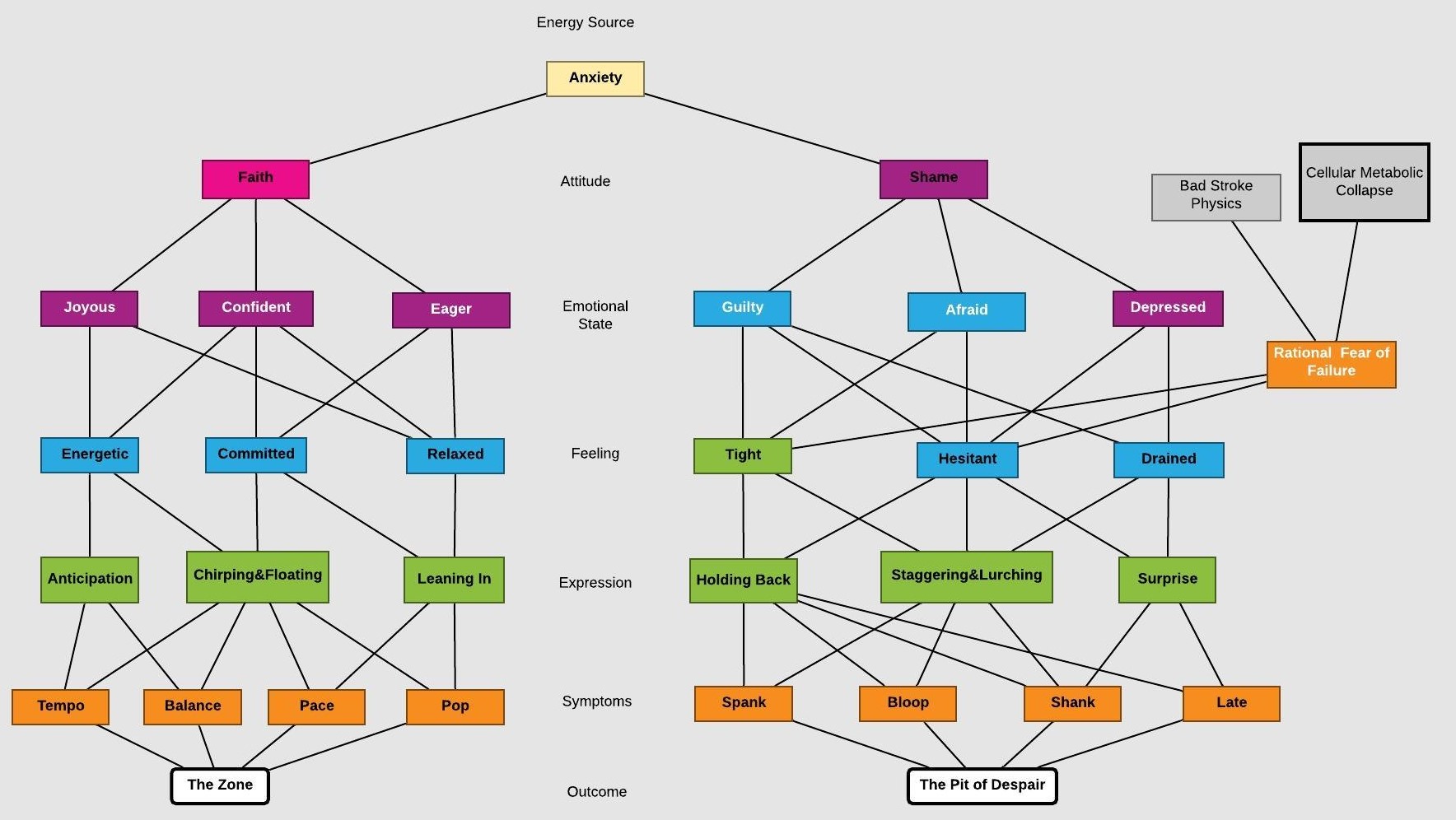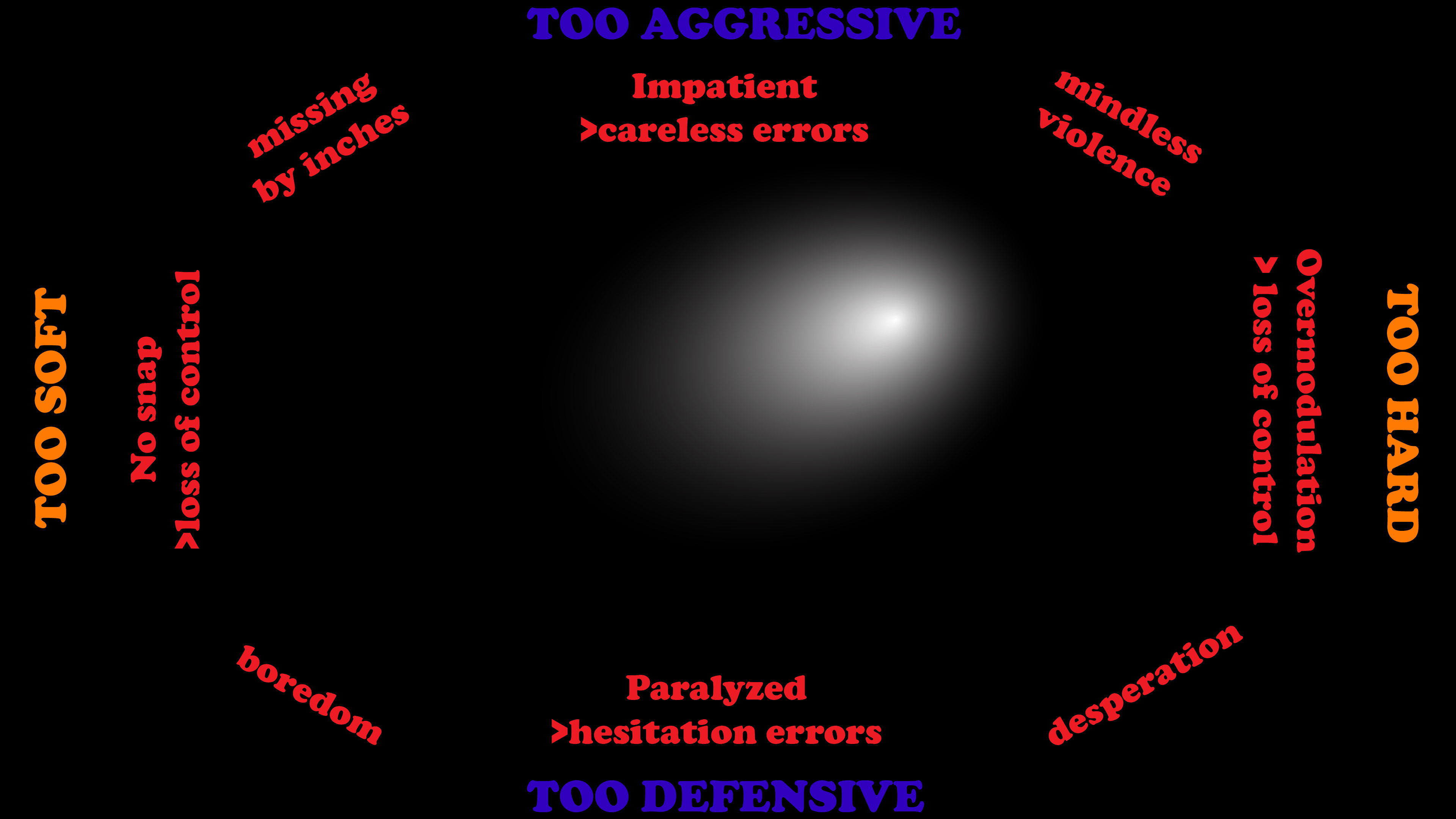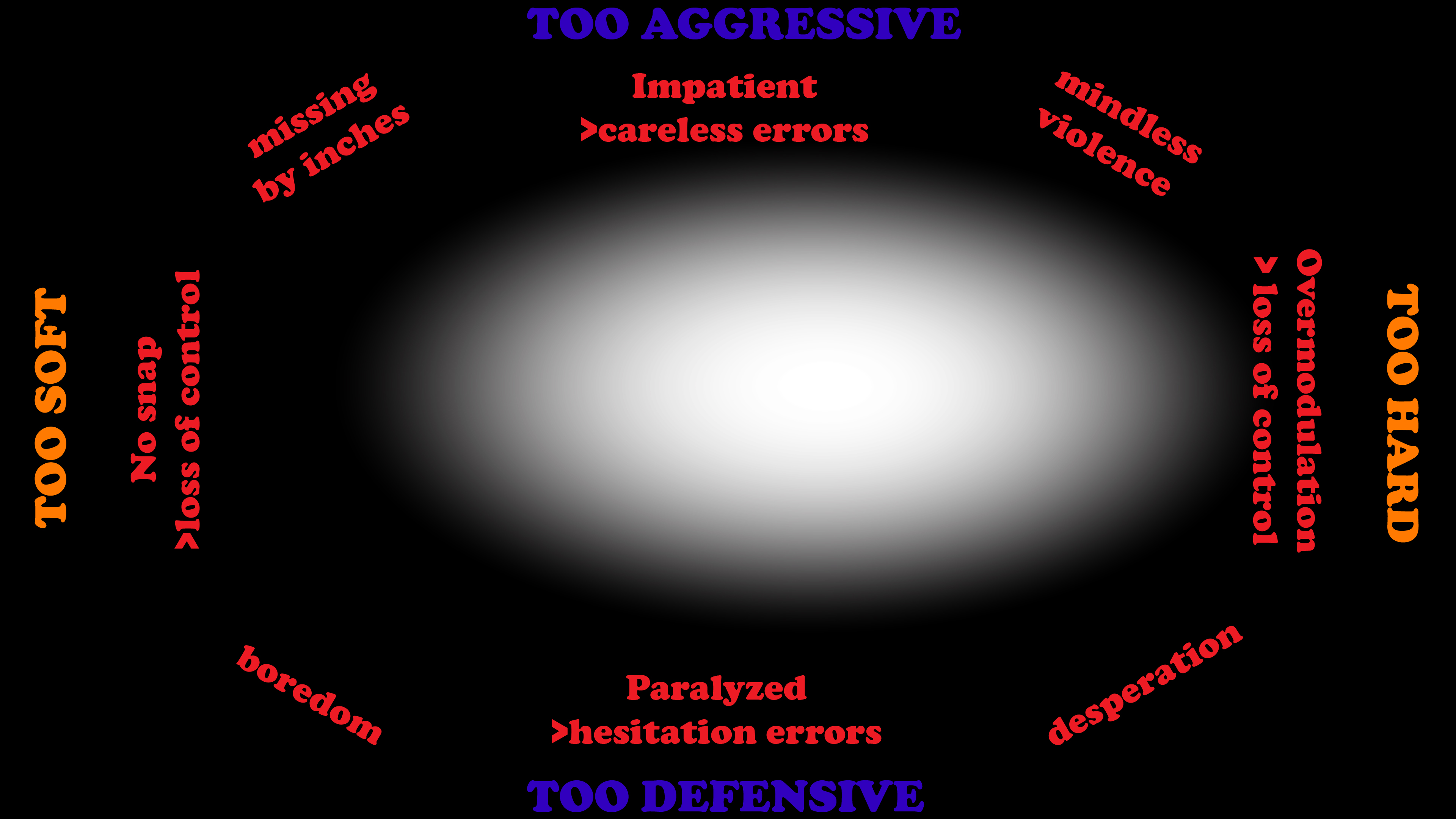
The Mental Zone
The Zone is your happy place. It is where you are when thinking is unnecessary, everything is natural and beautiful, and you can seemingly do no wrong. During a tennis match, your serves are suddenly overpowering, your forehand unerring, and your backhand not-as-pathetic-as-usual. The Zone is as much a phenomenon of hackers, duffers, and other fellow travelers as it is of professional tennis players. If the Zone is the ideal, then the Pit of Despair is tennis Hell. Whenever you find yourself relegated to that infernal realm, you rediscover your penchant for unconscionable errors, egregious form, and deep self-loathing.
As natural and wonderful as it feels to be in the Zone, that is how perplexed and helpless you feel in the Pit. You find yourself missing shots that you never miss, should never miss, and can't be missed even by the rankest of rank beginners. It's the shoulder-high sitter that you volley into the base of the net, the routine approach shots that keep hitting the net strap, and the serves that careen off the racket frame... I could go on, but I am sure that I am aggravating your PTSD (Putrid Tennis Stress Disorder).
Anxiety
OK, here is the good news; whether you end up in the Zone or the Pit is (somewhat) under your control. There are actual, conscious attitude changes that can direct your energies positively and increase the likelihood that you end up in Elysium rather than Abaddon. The real key is how you manage your natural, beneficial anxiety. That's right; I propose that anxiety is good. Anxiety is nothing more or less than the energy of existence in its purest form. It is how and why we get up in the morning, do our chores, study our lessons, and brave all kinds of hardships... without anxiety, we would be a species of lazy slugs. We certainly would not subject ourselves to the ego-bending vicissitudes of tennis. Anxiety engenders the release of beneficial hormones such as adrenaline, norepinephrine, and serotonin. These hormones ready us for a fight-or-flight response to a perceived threat. They make us faster, stronger and more alert. Wouldn't that be a nice way to be in a close tennis match? Anxiety gets a bad rap because uncontrolled anxiety can lead to exhaustion, depression, hyperventilation, and distraction. So how does one control anxiety? Attitude. If we perceive anxiety as a threat, sensing anxiety will make us even more anxious - a positive feedback loop permitting anxiety to increase beyond our control. On the other hand, if you embrace anxiety as a friend and ally, a negative feedback loop is established. As anxiety increases, we welcome it, which decreases our anxiety - but we want to be anxious (fired-up), so we crave more anxiety increasing our anxiety which makes us feel less anxious... Negative feedback loops are inherently stable and are the basis of control for almost every system in our bodies. All you have to do is convince yourself that your nervousness is tremendously beneficial and totally under your control, and boom! You are on your way to the Zone.
Faith
The next step is to convince yourself that the anxiety-provoking threat you perceive is not a real threat but is an opportunity allowing you to channel the energy of anxiety towards performance and success. To accomplish this, one needs only to choose Faith over Shame. A lot of bad things happen to your ego during a tennis match. The game seems designed to vex us. It is. If it were not vexing, if perfection were possible, the game would be pretty boring. Even the best players in the world dump the occasional easy volley or double-fault in the tie-breaker. One important difference between them and you is that they do not take it personally. They perceive each setback as the result of fate, not a personal failure. They truly believe that there is nothing wrong with them or their games.
An egregious error does not reflect negatively on them. It's just life - or just tennis, anyway. They don't blame themselves, their stars, or even God because God is on their side. I grant you that A-players have a history of enormous success to bolster their beliefs while you have a litany of failure and degradation punctuated by the occasional "good day" that seems much more the exception than the rule. Notwithstanding your checkered tennis past, if you want to improve your game and spend more time in the Zone and less in tennis perdition, you must cultivate Faith. You must learn to set your tennis past aside completely and convince yourself that it is N/A, non-applicable to your tennis present or future. You must ignore your painfully apparent lack of talent and presume that you can play the game you want and need to play (bolstered by the knowledge you are garnering by visiting this site). Most of all, you must believe that what you are trying to do to the tennis ball is what you should be doing. This last is the most important. It is why I am terrified of black pearls, meticulous about testing and confirming everything, and obsessed with understanding the deepest whys and wherefores of the game. Ultimately Faith must rest on a foundation of truth, or it cannot stand against doubt, shame and fear, for they are mighty and unremitting in their desire to corrupt your game. You can invest foundational Faith in a coach, a hero, a mentor, or a belief system, but make no mistake - Faith is the ultimate goal. Without unshakable, irrational, blind Faith, you will always fall prey to shame.
Shame
Shame is the absolute conviction of one's inadequacy. On the tennis court, it coerces us to question our methods, motives, and native abilities. Shame tells us that our failures are unavoidable and uncontrollable and that the fault is in ourselves, not our stars. There is always enough truth in these pernicious beliefs to corroborate our shame, and when we allow it to pull us down into the Pit, the tragic results perpetuate an intractable shame cycle. Shame engenders guilt since all errors we commit are our "fault," fear since we carry within us the very devil that torments us, and depression owing to the apparent hopelessness of our situation. The only antidote to shame is Faith - unreasoning, unshakable, unsupportable Faith; Faith not that we will prevail, but that we can prevail. We are all at the mercy of fate, and acceptance of fate is the closest we get to mastering it. The goal is to perform to the best of your ability on a given day against a given opponent. That is being in the Zone. That is as good as it gets in sports.
The Dark Side
Don't forget to exploit hostility towards your opponents. After all, they are doing everything they can to cause you to play badly. Redirecting your anger from yourself to your opponents is a powerful poultice against shame and negativity. Regrettably, the aphorism "Nice guys, finish last!" contains more than a particle of truth. Somewhere between being a total jerk or a self-hating loser, there is a sweet spot - an attitude that earns you the respect of your opponents without making you a pariah.
Factors Beyond All Control
It is not always possible to find the Zone. If your stroke mechanics are poor, a positive attitude will not help you. If you fail to snap the wrist (lock, load, and explode), then you will get no impulse, no control, and the ball will take a random vector off of your racket face. In that circumstance, you should expect to make errors. Similarly, if you starve your muscle cells of glucose, fat, calcium, or oxygen, they will stop listening to your brain, and your balance and stroking will go all to hell, taking your game down with them. I call this sad circumstance "Cellular Metabolic Collapse" and it is both a sneaky performance killer and an impenetrable barrier to entry of the Zone.


